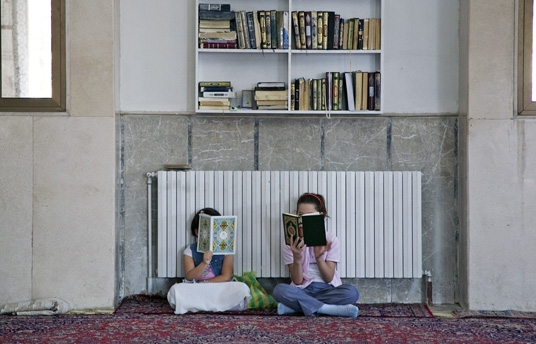DFI Film Review: The Light in Her Eyes
Jul 28, 2013

By Abbas Moussa
When international and American media looked at the status of women in Afghanistan when US troops invaded in 2001, one image was prominent: veiled women, illiterate, depressed and ignorant. This image was not a new one, but it greatly deepened the entrenched stereotypic image of Muslim women – and Muslims in general. Is this image true or it is only globalised? Is this what Islam wants for women? Or is social tradition influencing this portrayal of women in Islam?
These questions led two American directors to examine the reality of the lives of Muslim women today, in the light of social, political and intellectual changes. Lora Nicks and Julia Miltzer made ‘The Light in Her Eyes’ about a Syrian activist who has successfully shown or improved the image of Muslim women. The documentaryclosely follows Huda Al-Habash, in her efforts to show that Islam is not at odds with the lives of contemporary women. Islam guarantees women the right to actively practise all their societal roles alongside religious duties such as prayer and taking the hijab.
Al-Habash uses the Al-Zahraa mosque in Damascus as a base to operate her defence of the rights of women, to educate them, and to correct false stereotypes about women in Islam. She enabled an entire generation of girls to be aware of their rights through teaching the Qur’an and the tenets of Islam, which has given them the right to education and employment, and to contribute to society in all aspects of their lives. Al-Habash challenges traditions and social trends that say women must stay at home and serve their families, care for the household. and raise children.
The camera accompanies Al-Habash in the mosque when she delivers lessons to the girls and inspires them to adhere to their religion and demand their rights. It also follows her to her home while she is doing housework. Al-Habashg demonstrates that there is no conflict between being an Islamic activist who does her part to educate society and promote education, and the household duties that are required of her as a devout Muslim. This sends a message that there are many options for women – not only being a housewife, or a liberal society lady.
Directors Nicks and Meltzer say they wanted to show a different image of Muslim women that is not well-known in the West, where people generally place women into one of two categories: liberated or depressed. This film shows another category: women who are devout, but who are empowering themselves through education and development.
Al-Habash says she was successful in attracting hundreds of girls to her school who now recite the Qur’an, and she criticises many Muslims for their attitudes toward women. ‘Muslims prevent women from doing everything and deny them the right to educution. This is not related to religion at all.’ Al-Habash vehemently rejects the statements of some clerics on Islamic television channels, who say that women are merely followers of men; she insists that they present an incorrect and damaging interpretation of Islam.
Al-Habash encourages the girls to adapt to modern times, assuring them that Islam gives women full rights, ‘even if they want to be President.’ Perhaps her greatest impact on her students is that they are now keen to continue their education. One of her students says, ‘I want to go to college, but in our society when we are still in secondary school, we feel pressure to get engaged to a man.’
‘The Light in Her Eyes’ was shot in secret, away from the gaze of authorities, just before the beginning of the recent Syrian popular uprising.
‘The Light in Her Eyes’ shows Muslim women through the eyes of Western women. It illustrates for westerners some unknown aspects of the practice of Islam for women, moving away from representations of ignorance and isolation. It is a film in which Islam is seen to be a religion that gives women their rights, and makes them the teachers of all generations.
The Light in Her Eyes – Trailer